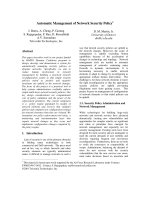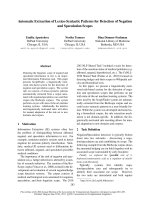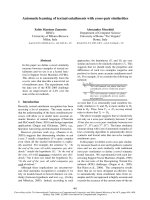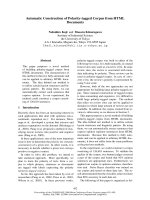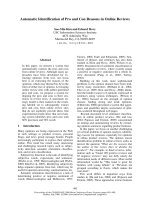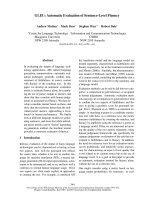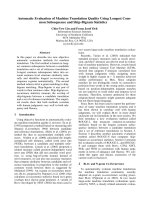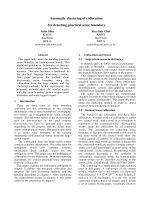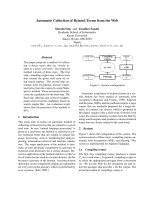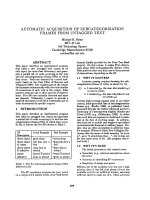Automatic Authoring of Adaptive Educational Hypermedia
Bạn đang xem bản rút gọn của tài liệu. Xem và tải ngay bản đầy đủ của tài liệu tại đây (708.65 KB, 51 trang )
Automatic Authoring of Adaptive Educational
Hypermedia
Alexandra I. Cristea
Faculty of Computer Science and Mathematics
Eindhoven University of Technology
Postbus 513, 5600 MB Eindhoven, The Netherlands
Tel: +31-40-247 4350
Fax: +31-40-246-3992
Craig Stewart
School of Computer Science and Information Technology
University of Nottingham, Jubilee Campus
Wollaton Road, Nottingham, NG8 1BB, UK
Tel: +44 115 846 6505
Fax: +44 115 951 4254
Automatic Authoring of Adaptive Educational
Hypermedia
Abstract
Adaptive Hypermedia (AH) can be considered the solution to the problems arising
from the “one-size-fits-all” approach to information delivery prevalent throughout the
WWW today. Adaptive Educational Hypermedia (AEH) aims to deliver educational
content appropriate to each learner, adapted to their preference and educational
background. The development of AEH authoring tools has lagged behind that of
delivery systems. Recently AEH authoring has come to the fore, with the aim of
automating the complex task of AEH authoring, not only within a system but porting
material between different AEHs. Advances in intra-system automation are described
using the LAOS framework, whereby an author is only required to create a small
amount of educational material which then automatically propagates throughout the
system. Advances in inter-system conversions are also described; the aim is to move
away from a “create once, use once” authoring paradigm, currently in force with most
AEH systems, towards a “create once, use many” paradigm. The goal is to allow
authors to use their content in the AEH delivery system of their choice, irrespective of
the original authoring environment. As a step along this road we describe the usage of
a single authoring environment (MOT) to deliver content in three independentlydesigned Educational Hypermedia systems (AHA!, WHURLE and SCORMcompliant Blackboard).
This chapter describes therefore advances in automatic authoring and conversion
towards a simple and flexible AEH authoring paradigm.
INTRODUCTION TO AEH AUTHORING
Adaptive hypermedia (AH; Brusilovsky, 2001a) started as a spin-off of hypermedia
and Intelligent Tutoring Systems (ITS; Murray, 1999). Its goal was to bring the user
model capacity of ITSs into hypermedia. However, due to technical limitations, such
as bandwidth and time constraints, AH only implemented simple user models. This
simplicity also gave AH its power as, suddenly, there were many new application
fields and also implementation was considerably easier. Early AH research
concentrated on variations of simple techniques for adaptive response to changes in
user model. No wonder that most of AH development was research-oriented, applied
only to the limited domain of courses the researchers themselves were giving (AHA!,
De Bra & Calvi, 1998; Interbook, Brusilovsky et al., 1998; TANGOW, Carro et al.,
2001) and with very rare commercial applications (Firefly, developed at MIT Media
Lab. and acquired by Microsoft).
Recently there has been a shift in attitudes. The development of the Semantic Web
(Berners-Lee, 2003), and the ongoing push to develop Ontologies (Gruber, 1992) for
knowledge domains has extended the importance of AH. Indeed AH now appears to
be the tool of choice for collating the static information of these new approaches and
bringing then to life.
Moreover, AH is spreading from its traditional application domain, education, to
others, especially the commercial realm, which is eager to be able to provide
personalization for its customers. Indeed, we often see the phenomenon from other
communities re-inventing adaptive hypermedia for their own purposes and
applications.
Adaptive Educational Hypermedia (AEH; Brusilovsky, 2001b) is, in principle,
superior to regular Educational Hypermedia (EH), as it allows for personalization of
the educational experience. Regular EH, such as that delivered by WebCT and
Blackboard is not adaptive: exactly the same lesson is delivered to each student.
Pedagogical research has shown (Coffield, 2004) that different learners learn in
different ways. This is a truth self-evident to most teachers; if a student is having
trouble learning a subject, then they will alter the manner in which they are teaching it
and try a different approach. Traditional EH systems could be compared to inflexible
teachers, who base their lesson mainly on drilling and repetition. Educational systems
(real or virtual) that adapt their presentation to the needs of each learner aim to
improve the efficiency and effectiveness of the learning process. If each learner has
their own Learning Style (Coffield, 2004) and is given a set of resources specific to
this particular style then that learner will not only learn ‘better’, but will be able to
more effectively develop the given information into deeper understanding and
knowledge. AEH systems seek to address the inflexibility of current EH methods.
Systems such as MOT, AHA! and WHURLE all answer the need for an adaptive and
flexible approach to teaching. They allow current online educational systems to break
away from the “one-size-fits-all” mentality and move towards having an appropriate
lesson for each student.
AEH systems aim to improve upon current static EH systems. This is not to say that
they are the universal panacea for online education. Education is not undertaken in a
vacuum; the social aspect is also vital. It is essential for learners: to be able to build
common ground; to ask and answer (negotiate meaning); to argue and debate; to
explicate mental models; to share expertise; to collaborate; and to construct novel
ideas and understanding. Work on computer-supported cooperative work (CSCW)
addresses this side of the educational process, and often AEH systems will fold this
research into them (for example WHURLE can be used in such a social manner).
Collaborative work can be encouraged by the use of simple online social tools: email,
for asynchronous communications; fora, for persistent asynchronous group
discussions; and chat rooms, for synchronous group discussions. The addition of
Adaptation to this whole structure is another improvement to the student’s personal
online educational experience.
However, with increasing numbers of students, and the resulting increase in class size
of many learning bodies, traditional methods of education (such as the tutorial, and
the field trip) often become impractical – in terms of time and cost. Online education
can help to fill this need, EH and AEH were developed to do just this.
Given the qualities of AEH systems, it might be reasonable to expect a much wider
uptake than actually is happening. A major hindrance of this is that the creation of
good quality AEH is not trivial, often involving a greater expenditure of time and
money to produce, when compared to standard online educational systems.
Creating content within a single AEH system can be a complex and difficult
undertaking.
Many issues must be considered, amongst them:
•
What knowledge domain(s) will the lesson partake of?
•
Do any previous e-learning materials exist that are both available and reusable?
•
What are the objectives of the lesson and how are they to be achieved for a
heterogeneous group of learners?
•
Which traits of a learner are to be modelled and how is this User Model
created?
•
How is the data, concerning these traits, to be gathered, implicitly (without
the learner’s knowledge) or explicitly (information is requested from the
learner)?
•
Given that there exists a heterogeneous group of learners how many versions
of the same material need to be created? For example, if a group of learners
are to be divided into two sub-groups, one which requires visual materials and
the other which requires textual based materials, then it follows that at least
two sets of the material are required to teach that lesson.
•
What are the rules for adaptation? Does the author of the lesson have any
control over their use or creation?
•
How are the various versions to be presented to the learner, and does the
learner have any control over this?
Most AEH systems require the author to consider these issues with little or no help.
The author is left adrift and often must become an expert in Adaptive Hypertext
before creating anything.
It is hardly surprising then, that AEH systems are not used widely outside of their own
development circles, as these developers are the only people with the required level of
expertise to create content for them! This problem arose whilst AEH was still a new
area of research. A natural “one-to-one” paradigm developed, with developers
creating the AEH system that was specific to their desires and insights, along with the
necessary authoring tools. Cross-platform considerations were not important;
transporting data between systems was generally considered irrelevant.
Nowadays, a lot of research effort concentrates on the ‘authoring challenge’ (Wu et
al., 1998; Specht et al., 2001; Murray, 2003; Cristea & Cristea, 2004) in AEH, with
the goal of reducing complexity, thereby delivering the greater flexibility of an AEH
for the same cost as current online systems. This chapter approaches this challenge
from the point of view of automation, minimizing, but not restricting, the author’s
input and reducing overload.
Advances in inter-system conversions are also described, the aim being to move away
from a “create once, use once” authoring paradigm, as with most AEH systems;
towards a “create once, use often” paradigm. The goal is to allow authors to use their
content in the AEH system of their choice, irrespective of the original authoring
environment. As a step down this road we describe using a single authoring
environment (MOT) to deliver content in three independently designed Educational
Hypermedia systems (AHA!, WHURLE and SCORM compliant Blackboard).
The remainder of this chapter is organized as follows. First we present LAOS, a
generic AH authoring framework that incorporates several layers of semantics to
better express the authored AEH. The major part of this chapter focuses on the two
major dimensions of AEH authoring automation that we have identified: automation
within an AEH authoring environment, and automation outside it, comprising
conversion between AEH systems. Finally we draw conclusions.
LAOS LAYERED MODEL
The LAOS model (Layered AHS Authoring-Model and Operators; Cristea & De
Mooij, 2003c; Figure 1) addresses the issue of AEH authoring complexity by dividing
it into subtasks corresponding to five explicit semantic layers of adaptive hypermedia
(authoring), that together act as a framework for designing an AEH.
Figure 1. The LAOS Adaptive Hypermedia (Authoring) Framework
These five semantic layers of LAOS are:
•
domain model (DM), containing the basic concepts of the contents, and their
representation (such as learning resources)
•
goal and constraints model (GM), a constrained version of the domain
model. The constraints are based on educational goals and motivations.
•
user model (UM), represents a model of the learner’s educational traits.
•
adaptation model (AM), a more complex layer that determines the dynamics
of the AH system. Traditionally, this layer is composed of IF-THEN rules and
therefore the LAOS version also translates such rules at the lowest level.
•
presentation model (PM), is provided to reflect the physical properties and
the environment of the presentation; it reflects choices, such as, the
appropriate background contrast to support a learner with poor eyesight.
Each of these semantic layers are composed of semantic elements. LAOS allows
flexible (re-)composition of the defining semantic elements of the layers, according to
each learner’s personalization requirements. We are not going to go into details about
the semantic elements, except for those directly used in internal automatic
transformations or external conversion. At this point, it suffices to remark that the
LAOS structure simply serves to make explicit the complex layers of an AEH system.
Such a detailed structure requires a lot of time to populate with AEH instances. As an
alternative, we discuss semi-automatic authoring techniques, which populate the
whole structure based on a small initial subset that has been authored by a human.
Here we analyze two different possible initial subsets:
•
internal semi-automatic authoring: the theoretical analysis of the semiautomatic generation of one LAOS layer based on (the content and structure
of) another one. The practical analysis of this is performed in MOT (My
Online Teacher, Cristea & De Mooij, 2003d). In short, we see this research
line as another step towards adaptive hypermedia that ‘writes itself’.
•
external semi-automatic authoring: the theoretical and practical analysis of
conversions between AEH authoring systems, such as MOT, into AEH
delivery systems, such as AHA! and WHURLE (Moore, 2001) or educational
systems, such as Blackboard. We examine the structures resulting from using a
single authoring system to convert content for use in each system. In effect we
propose a paradigm shift for AEH authoring, away from “write once, use
once” (i.e., every AEH has its own authoring systems) towards a middleware
system that allows for delivery of the same material to many different AEHs.
We describe the current “state of the art” towards this goal – using MOT as an
authoring environment to deliver adaptive content to WHURLE and AHA!
(also the connection to Blackboard).
TRANSFORMATIONS WITHIN AN AEH SYSTEM
Adaptive Educational material is obviously more difficult to create than linear
educational material, because of the alternative content versions and path descriptions.
Therefore, we investigate the possibilities of automatic generation of some of the
LAOS layers, using information from other layers. In the following sections, we will
sketch some of these transformations, focussing on their semantics. The flexibility of
general transformations has been addressed in (Cristea, 2004)
From Domain Model to itself (DM→DM)
The DM contains the learning resources of the AEH, such as the actual course
materials, figures, graphs, videos, etc. These resources are grouped under the domain
concept they belong to, using the established domain semantics. That is, resources are
grouped into attributes of given (rhetoric or other) types, such as ‘text’, ‘introduction’,
‘conclusion’, ‘figure’ etc. The DM also contains the links between the semantic
wrappers of the domain resources, such as links between concepts, grouping them into
concept hierarchies, or other relatedness links. This section discusses the way in
which the DM can be automatically (adaptively, adaptably) enriched, by interpreting
the semantics of its structure and contents.
New semantic links. The easiest way to enrich the domain model is by automatically
finding new domain links between existing domain concepts1.
For instance, new relatedness relations can be generated for relations between
concepts that share a common topic. This commonality can be computed at concept
attribute level, and therefore can automatically be labelled with a type that
corresponds to the type attribute of the connecting attribute. In the following, we
illustrate this with the help of an abstract example:
Consider, we have two domain concepts from two possibly different domain concept
maps, c1∈C1, c2∈C2 (concept ‘NN Introduction’ and concept ‘The biological
neuron’ from the concept maps ‘Neural Networks I’ and ‘Neural Networks II’
respectively2). Now consider now two respective attributes of these concepts a1∈c1,
a2∈ c2; these attributes can be given as pairs of variable names and their respective
values: a1=<var1,val1>, a2=<var2,val2>. If the attributes are of the same type (var1=
var2=var; for instance, var=‘keywords’) then a weighted, typed semantic domain
link can be generated between the two concepts c1 and c2, with the link type (label)
given by the type of the attribute, and the weight defined as the number of common
features between the two value fields: weight=number_common_features(val1,val2).
This link will only make sense if the weight is positive.
These new links can be between the concepts of the current content (concept map: e.g., course),
between the current content and some other content created by the same author, or finally between the
current content and some other content created by a different author.
2
Examples taken from LAOS implementation in MOT.
1
This is one semantically explicit, symbolic way of generating new links between
domain concepts. Another way is, for instance, to apply an algorithm that checks the
domain map for missing link types, and prompts the author, asking if new ones should
be searched for.
New semantic attributes. A different method to enrich the domain model involves
link analysis to compare semantically similar concepts (semantically similar can mean
similar from a link-point of view, such as concepts sharing the same ancestor-concept,
for example; or concepts at the same level of the hierarchy; or concepts related with
each other via some special link (of a given type), etc) and to find if some attributes
(or even sub-concepts) are missing.
For instance, consider a concept called ‘Discrete Neuron Perceptrons’ from a Neural
Networks course that has an attribute of the type ‘Example’, whereas the concept
‘Continuous Neuron Perceptrons’ doesn’t, although they are linked via a relatedness
relation as described in the previous sub-section.
In this case, the system can signal the author concerning the possible ‘missing’
content item, corresponding to the semantics (attribute, sub-concept, etc.). It may even
look for possible candidates for the ‘Example’ attribute via other links to this concept.
This search space is not limited in scope but can continue ‘outside’ the LAOS model,
leading to a transition from a closed space to the Open Adaptive Educational
Hypermedia space.
From Domain - to Goal and Constraints Model (DM→GM).
The Goal and Constraints Model filters, constrains and restructures the Domain
Model, corresponding to a pedagogic goal. For instance, a lesson aimed at beginners
starts by filtering the necessary introductory information from a larger pool defined by
one or more appropriate domain maps. Therefore, the primary content of the GM are
not resources, but copies of (or, rather, to avoid redundancy, pointers to) the resources.
The Goal and Constraints Model also contains prerequisite relationships that establish
the general recommended order of visiting the course items. Moreover, here the
differentiation is made between alternative content (OR relations) and obligatory
content (AND relations). Therefore, the GM Model contains mainly structural
elements, or links. The GM can also contain resources, if these are of a pedagogical
nature only (such as a text explaining why it is better for beginners to study resources,
grouped as attributes, with the type ‘Introduction’).
Automatic (adaptive, adaptable) Goal and Constraints Model enrichment or creation
based on the Domain Model can be achieved based on semantic presentation
constraints or goals (e.g., envisioned pedagogical strategies or pedagogical
techniques). This transformation represents the first step from information to
knowledge, therefore promoting a higher level of semantics.
Semantic generation of Primary content. Concept attributes, as has been
mentioned, can be grouped into types. A semantically relevant subset of these types
can be used to determine a semantic filter for the selection of the items that will
appear in the Goal and Constraints Model. The filter represents the constraints in the
GM model, while the semantics of the filter represents the goal.
For instance, a lesson dedicated to beginners can form a filter containing domain
attributes of types such as: ‘Introduction’, ‘Explanation’. These attributes can be
semantically grouped in the GM as alternative contents (OR) and obligatory contents
(AND) concepts.
Semantic Generation of Links. Links in the domain layer can be, as previously
noted, hierarchical, or of another nature. These link types can be used to generate
specific links at the level of the GM model.
For instance, the GM model can be generated by filtering only links of a specific
semantically relevant type (e.g., only hierarchical links). These links then are
semantically interpreted, therefore becoming prerequisite relations. In MOT,
automatic transformations of hierarchical links are used to create a hierarchical,
ordered link structure; i.e., the selected attribute subset will keep the same
hierarchical structure as its DM source. However, the semantics changes from an
inclusion hierarchy to that of a prerequisite hierarchy.
From Domain - to Adaptation Model (DM→AM)
The role of the adaptation model is to interpret the other models: the domain –, goal –
and even presentation model. Moreover, it can update these models and generate the
presentation. Typical elements of the adaptation model are condition-action (or IFTHEN) rules that change learner model variable values or presentation aspects. LAOS
actually uses the LAG model (Layered Adaptive Granulation, Cristea & Calvi, 2003)
to express adaptation with richer semantics. LAG has, at the lowest level, adaptation
assembly rules such as IF-THEN rules, but wraps them in a second layer of an
adaptation language, and at the highest level adaptation strategies. There are not
many semantic descriptions at the lowest LAG level, hence the semantics are built
into the other layers. The semantics of the adaptation language correspond to typical
educational adaptation constructs that commonly appear during different adaptive
interactions with the learner. The highest level, adaptation strategies, correspond
semantically to pedagogic strategies.
Automatic (adaptive, adaptable) adaptation model enrichment based on the Domain
Model is also a matter of semantic interpretation, with respect to a goal, e.g., a
pedagogical strategy.
Automatic Semantic Rule Generation based on attribute types. Attribute types can
be used to semantically create rules that control the display of specific types of
attributes under specific conditions. These conditions can be automatically deduced
by the system (as in adaptivity) or triggered by the AH user (adaptability).
For instance, a generated specific automatic adaptive rule can express the fact that we
only want to show the domain attribute of type ‘text’ of concept c1 after the attributes
with types ‘title’ and ‘introduction’ were accessed:
IF(c1.title.access=’TRUE’ AND c1.introduction.access=’TRUE’)
THEN c1. text.available=’TRUE’;
Note that we wrote the condition in this form for simplification purposes, and that
attribute states such as ‘access’ and ‘available’ are part of the user model.
In order for this to be a generic automatic transformation rule, that can be applied to
any concept in the domain model, the rule becomes:
IF(concept.title.access=’TRUE’ AND concept.introduction.access=’TRUE’)
THEN concept. text.available=’TRUE’;
From Goal and Constraints - to Adaptation Model (GM→AM)
The Adaptation Model should actually work together with the Goal and Constraints
Model, as the latter is the filtered version of the initial information, tailored for the
group (stereotype) of learners envisioned. The Adaptation Model fine-tunes this
stereotyping, catering for the individual learner’s needs, as opposed to the groups
needs. Enriching or generating the Adaptation Model based on the GM means
semantically interpreting the GM according to an adaptation strategy or technique
(e.g., based on a pedagogical strategy or technique).
Automatic Semantic Rule Generation based on Link Type. The GM, as said,
contains pre-ordered and pre-selected information from the DM. This structure can
already be semantically interpreted in terms of the adaptation that is to be performed
on it. For instance, the GM allows ‘AND’ relations between concepts, as well as ‘OR’
relations with some weights.
These can be used to automatically generate rules that express the requirement that all
concepts in an ‘AND’ relation must be read:
IF ((c.name.access=’TRUE’ OR c.contents.access=’TRUE’)
AND link(c,c2,’AND’,*))
THEN { c2.name.accessible=’TRUE’; c2.contents.accessible=’TRUE’;}
In a similar way, an ‘OR’ relationship can be semantically interpreted into inhibition
rules:
IF ((c.name.access=’TRUE’ OR c.contents.access =’TRUE’)
AND link(c,c2,’OR’,*) )
THEN { c2.name.accessible=’no’; c2.contents.accessible=’no’;}
In such a way, various constructs can be automatically added to the generic adaptation
rules, directly by interpreting the goal and constraints model.
From User - to Adaptation Model (UM→AM)
The LAOS user model is a hybrid model (similar to Zakaria & Brailsford, 2002). This
means that the learner model consist of a stereotype model and an overlay model.
The first consists of variable-value pairs, which specify, information on a student; for
instance:
•
Interests (e.g. main interests, cross domain interests, etc.)
•
current educational status
•
residential constraints (e.g. preferred cities, max distance to travel per day,
etc.)
•
preferred study duration
•
language (e.g. mother tongue, preferred study language)
•
medical status
•
age
Variables as above can enter conditions in adaptive rules or can be modified by these
rules.
The second model specifies not only variable-values, but also the relationships
between these variables, which can be deduced from the underlying domain model (or
goal and constraints model).
Automatic Semantic Rule Generation based on Attribute Type. To illustrate a
semantic interpretation of user model elements to generate an AM rule, we consider
the state of ‘interest’ a learner manifests about a concept. A possible semantical
interpretation of this state, evaluated via the domain overlay attribute with the same
name, is to generate a rule that displays everything in the concept, if this concept is of
interest to the user:
IF (concept.interest > threshold)
THEN {concept.name.available=’TRUE’; concept.contents.available=’TRUE’;}
Note that this rule is a generic rule, which can be applied on all concepts in a concept
map, drastically reducing the workload.
UM→AM: by Link Type. Link type can only be used when the UM is itself a
concept map. Via UM links we can express for instance the fact that two states in the
user model are related.
Here, however, we try to look at a different type of link between UM concepts. For
this, let’s consider the link of type ‘influence’. Such a link can be automatically
interpreted into a rule saying that the interest in a subject c might decrease if the user
is interested in another subject c2.
IF LINK(c,c2,’influence’,*)
THEN {c.interest= c.interest – c2.interest;}
CONVERSIONS BETWEEN AEH SYSTEMS
Paradigm Shift (one-to-one many-to-many)
LAOS addresses many of the issues regarding the complexity of authoring, but cannot
cover all of them. This is because the problem is compounded when one considers
other factors, such as, software rot and the multitude of systems available. Software
rot occurs over time because software is not maintained or software necessary for the
correct workings of a program is altered in such a way that the original code ceases to
function correctly. Imagine a situation where an author goes to the not inconsiderable
time and trouble to create a lesson in an AEH system, be it based on LAOS or not.
What happens if this system ceases to be maintained? As many AEH systems are
currently developed by individual research groups around the world, the above
situation has occurred many times and will occur again. Before this happens the
author must consider the future. Does he stay with the old system that will slowly rot
away? Or does he spend the time and effort to learn how to author in a new AEH
system? It is possible that the original content is locked into the previous format,
hence he may have to re-create all of his old lessons.
With the ongoing growth and maturation of AEH, these issues are raised. It is more
widely recognised as desirable to move away from a “one-to-one” AH authoring
paradigm to a general “many-to-many”. That is, an author may create a lesson in any
system he is an expert in, or wishes to spend the time and effort to learn, and export
(or convert) this data for use in an other system. It would be of no concern if an
individual system ‘rotted’ or was no longer available; a simple conversion from that
system to a new one would solve this problem. This is an extended form of authoring.
What follows is a description of the first steps taken in this direction. However, rather
than the ultimate goal of a “many-to-many” system we describe a half way point, a
“one-to-many” methodology. Using MOT as an authoring tool (as it is based on the
powerful and flexible LAOS framework) it is possible to create whatever content is
desired. It is then possible to transform the lesson into one of three different formats:
AHA!, Blackboard and WHURLE (actually there are four formats, but the original
MOT delivery format requires no conversion). The process involved in doing this is
described in the following sections.
Existing Multi-System Authoring Environments
In the following sections we will analyze some inter-system authoring experiments.
We will discuss how learning material can be created in one system, MOT, and
converted into other delivery systems. The conversions described below represent the
one-to-many paradigm shift.
MOT →AHA!
MOT (My Online Teacher) is an AEH authoring system based on the LAOS
framework. At the time of the writing, MOT implements the:
•
domain model, as a conceptual domain model for courses,
•
goal and constraints model, as a Lesson map,
•
user model, featuring stereotypes and overlay user model (Wu, 2002).
•
adaptation model (MOT-adapt), in the form of an (instructional) adaptive
strategy (Cristea, 2004c) creation tool, based on an adaptive language (Cristea
& Calvi, 2003) that uses as an intermediate representation level of LAG
(Layers of Adaptive Granulation) grammar (Cristea & Verschoor, 2004)
•
presentation model is currently being implemented, in the form of a hybrid
model, similar to the user model.
AHA! is a general-purpose adaptive Web-based engine, first created as a simple
support engine for adaptive on-line courses (De Bra & Calvi, 1998). The key features
of AHA! (version 2.0) are:
•
Open Source project
•
Web-based adaptive engine
•
Built on Java Servlet technology
•
Authoring through Java Applets
•
General-purpose user-model and adaptation rules
•
Extensive use of XML
•
Database Support using mySQL.
In addition to these, AHA! version 3.0 contains constructs called ‘objects’. These
‘objects’ allow a complex inclusion structure of elements of a learner presentation, in
a more flexible way than in earlier versions.
As MOT’s first version implemented only the domain and the lesson maps, the first
MOT to AHA! conversion focussed on the conversion of these maps only.
The version currently under implementation is aiming to make use of the new
facilities in AHA! 3.0 and the extensions in MOT.
In the following, these conversions will be sketched separately, from a semantic and
implementation point of view.
Semantic Mapping of the Domain Model
The MOT domain model layer contains a hierarchy of domain concepts and their
respective domain attributes. Moreover, the DM contains also (typed and weighted)
relatedness relations between domain concepts. The conversion from MOT to AHA!
was initially performed using AHA! v2.0.
AHA! v2.0 only knew how to handle conditional inclusion of fragments, which are
parts of an (xhtml) page. Therefore, the (xhtml) pages had to be generated for the
AHA! v2.0 engine.
Note however that if a concept attribute appeared in more than one condition, it had to
be pasted as a conditional fragment in each of the (xhtml) pages in which it could
appear. The object inclusion in AHA! 3.0 solves this redundancy problem. This is the
reason why the conversion process only started to function closer to the desired
requirements with the advent of AHA! 3.0.
A conversion of MOT domain concept maps into AHA! 3.0 implies the following
steps:
1. a first step of creating an XHTML (basic) resource file for every domain
attribute in MOT3. This will generate AHA! object concepts4 for each attribute
( Attr 1 to Attr k) in Figure 2.
2. a second step of grouping of domain attributes (representing the different
aspects of a concept that should appear when certain instructional strategies
are triggered) into XHTML files, containing lists of ‘objects’, pointing to the
XHTML files created in step 1. This will generate AHA! page concepts (as
shown in Figure 2).
3. The actual conditions that determine which (or how many) of the alternatives
are really shown to the student are written in AHA! rules during conversion
Semantically, this means that MOT domain attributes correspond to AHA! resources,
whereas MOT domain concepts correspond to a special type of AHA! concept called
‘page concept’.
AHA! page concept
XHTML file
MOT
DM
concept
AHA! object concepts
Attr.
XHTML files
1
Attr.
2
Attr.
3
…
Attr.
k
Figure 2. Semantic representation of MOT domain concepts and domain attributes in
AHA!
This only means adding a header and a footer to the attribute and saving it into a file with unique
name, <file-name>.xhtml.
4
AHA! has different types of concepts, such as object concepts, page concepts, etc. The type of the
concept specifies how the AHA! delivery engine will render the content of the respective concept.
3
The actual representation of the domain map conversion in the AHA! implementation
is shown in Figure 3. The figure shows how an AHA! page concept can be created by
connecting together a list of object concepts. The actual display of the object concepts
can be made to depend on some conditions (such as user preferences, state, etc.).
AHA!
page concept
(corresponding to
MOT concept)
<object name="attr-concept1" type="aha/text" />
<object name="attr-concept2" type="aha/text" / >
<object name="attr-concept3" type="aha/text" />
<object name="attr-concept4" type="aha/text" />
.
.
XHTML file
Figure 3. Implementation of MOT domain concepts and domain attributes in AHA!
Semantic mapping of the Lesson Model
The Lesson map has similar elements to the DM (as according to the LAOS model),
so similar conversions can be expected. One major difference is determined by the
(weighted) AND-OR relations, which can be directly interpreted as prerequisite
relations, allowed by the AHA! engine.
Lesson map conversion into AHA! 3.0 structure is similar to the conversion of domain
concept maps. The semantics are represented in Figure 4. The contents of the MOT
lesson concepts have previously been created as XHTML basic resources during the
domain attribute conversion, therefore this process is not repeated (i.e., the resources
that are connected to the attributes Attr. 1 to 3 in Figure 4 are already bound to some
AHA! object concepts, as shown in Figure 2. This is due to the LAOS restriction that
attributes of the Domain map become concepts in the Lesson map). These MOT
lesson concepts are then converted into AHA! page concepts, in a similar way.
